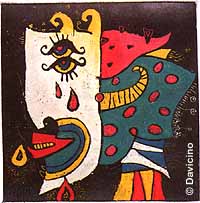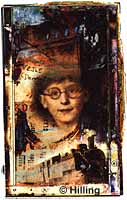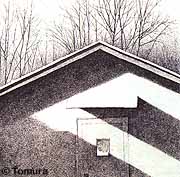| The 3rd
British International Miniature Print Exhibition Touring 1997-98 (Dates and Venues)
 |
El Kikucho
etching & aquatint by Elena Alejandra
Davicino |
With this third exhibition,
the British International Miniature Print Exhibition
is now established as an entity on the international
art scene, at least within its graphic art
constituency. The frequent letters of enquiry that
arrive at Off-Centre Gallery asking for information
about the dates of the next exhibition support this
view.
As I write I have around me the
catalogues ot Miniature Print Biennales from
Cadaques, Spain; Seoul, South Korea; Dublin, Ireland;
Budapest, Hungary; and Lodz, Poland, dating back
fifteen or more
 |
Different Trains
computer generated by Lesley Hilling |
years. Reading their
introductions heightens the challenge of finding a
new approach to the genre avoiding the much repeated
truisms. Two brief essays follow, on the miniature in
music and in literature and will, we hope, encourage
the idea that small-scale forms can contain and
express ideas that engage. It seems to us that it is
in the realm of contemporary visual art that this
mild proposition is more likely to be contested.
Facts and Figures
First some of the
specifics of our exhibition. As in 1994 we retained
the limitation of 70sq cms for the image, an area
limit rather than a specific maximum dimension in
order to encourage flexibility of format. In all,
1,700 entry forms were distributed, to artists'
organisations, journals, print workshops and
galleries world-wide, though inadequately for such
huge areas as China, S.E. Asia and Africa where our
contacts are few.
 |
Correlation VIII
mezzotint by Masataka
Kuroyanagi |
There were also
many direct requests from artists, the most numerous
responses being from countries where information was
circulated via specialist publications - for example
Argentina, Japan and USA. A little more detail about
this may be of interest.
From Argentina we
received 108 works from 44 artists (18 works
accepted); from Japan we received 132 works from 49
artists (23 works accepted) and from USA 75 works
were received from 29 artists (11 works included).
This, I find, is a ratio of approximately one
accepted out of every six or seven, by chance the
proportion which applies to the whole show.
Between late August
and the end of October 1996 we received 1,398 works
from 540 artists living in 40 countries. This figure
is about 430 works fewer than
in 1994, possibly
demonstrating a reasonable caution on the part of
artists who paid entry fees then but were not
selected in that year.
Selection
 |
In the Morning, February
etching by Shigeki Tomura. |
The Jury of five
artists met in Bristol on 1st and 2nd November 1996
and in two long working days selected 205 works by
155 artists from 23 countries(1)
The second day ended with an overall assessment
of the chosen works as an exhibition aiming to
represent the different strands within the submission
- colour and monochrome, abstract and figurative and
the adequate representation of contemporary
techniques. Potential prize winners were selected on
the basis of shared enthusiasm within the Jury
(rather than graded as 'best in the show').
The Exhibition
One innovation in the
presentation of this exhibition is the inclusion of
larger works by ten invited artists, who are also
represented by two or three miniatures. This
arrangement helps the aim of raising the status of
small-scale work by demonstrating that artists of
serious intent and achievement treat both smaller and
larger forms with the same intensity and respect. And
the larger works make a series of focal points
towards which the viewer will be drawn. As the
majority of exhibitors will not be able to visit this
exhibition I will include a few more words about the
presentation. All exhibits are individually framed in
stained narrow wood mouldings. Each image is backed
by acid-free card and surrounded by a hand cut
bevelled mount in off-white or ivory acid-free card
Two larger frames contain the many portrait
photographs - colour or black and white - which the
artists were asked to send. This is an attempt to
humanise and personalise the listing of names in the
catalogue. Further information about the exhibitors
is available for visitors in a file (at the gallery
desk).
Close
up
 |
Red Chair
lino cut by Claudio Lara |
One thing that
can be said about successful miniature prints is that
they require close attention from the viewer Unlike
larger prints, paintings or sculpture which in a
certain sense can be 'taken in' at a glance and from
a distance, the qualities of many miniatures do not
really register until looked at closely, even perhaps
with the aid of magnification(2)
The viewer is required to mimic for a few
moments the concentrated attention of the artist
during the process of making the image. In this
respect the best of miniature art is a kind of visual
poetry, the result of refining a visual idea until a
concentrated essence or distillation is achieved.
Well, maybe . ..but it is a pleasure that no
generalisation about art fits all categories. Artists
take delight in working against prescriptions.
Peter Ford
February 1997
1 Point of comparison: For the Miniature Print
Biennale in 1987 organised by the International
Graphic Art Foundation, USA, 451 artists submitted
1,068 works from which the Jury selected 156 for
exhibition. Back>>>>>
2 Anyone wanting to look further into
questions of scale, with a scientific slant, might
enjoy 'Powers of Ten', by Eames and Morrison,
published in 1982 by the Scientific American Library.
ISBN 0-7167-1409-4. Taking its central page as a
starting point, which shows two people relaxing at a
picnic, the pages focus ever more closely, each ten
times smaller, onto the hand, the skin, through the
cell structure, the protons and to quarks; whilst
from the centre to the front of the book each page
takes the viewer outwards, into the skies, past the
stars and to the darkness of the universe.Back>>>>>
TOUR
VENUES
At the time of going
to print - February 1997 - details of the tour are as
follows
LEICESTER 27th
February to 12th April 1997
The City Gallery, 90 Granby Street, Leicester
DEVIZES 26th
April to 24th May 1997
Handel House Contemporary Gallery, Sidmouth Street,
Devises.
RYE
31st May to 27th July
Rye Ad Gallery, Stormont Studio, Ockman Lane, East
Street, Rye, Sussex.
ABERYSTWYTH
(WALES) 9th August to 13th September 1997
Aberystwyth Arts Centre, Penglais, Aberyswyth.
UXBRIDGE
24th November to 19th December 1997
Beldam Gallery, Wilfred Brown Building, Brunel
University, Cleveland Road. Uxbridge.
LONDON
13th January to 1st February 1998
Bankside Gallery, 40 Hoptun Street, Blackfriars,
London SEl
BATHGATE
(SCOTLAND) 10th February to 25th March 1998
Balbardi Sports Centre Gallery Bathgate, West
Lothian.
Howden Park Centre Gallery Livingstone, West Lothian
DUMFRIES
(SCOTLAND) 31st March to 9th May 1998
Gracetield Ads Centre, 28 Edinburgh Road, Dumfries.
SHETLAND
(SCOTLAND) 22nd May to 21st June 1998
Bonhoga Gallery, Weisdale Mill, Weisdale, Shetland.
SWANSEA (WALES)
July - August 1998
Ceri Richards Gallery, Taliesin Arts Centre,
University of Swansea, Singleton Park, Swansea
BLEDDFA
(WALES) 30th August to 27th September 1998
The Old School Gallery. Bleddfa, Knighton.
RAMSGATE
October 1998
Ramsgate Library Gallery, Guildford Lawn, Ramsgate,
Kent.
CAERPHILLY
(WALES) November - December 1998
Tredomen Gallery, Cserphilly.
BRISTOL
1998-99
(Dates and venue under negotiation)
To top of page
|
 The information resource for printmakers
The information resource for printmakers
 The information resource for printmakers
The information resource for printmakers